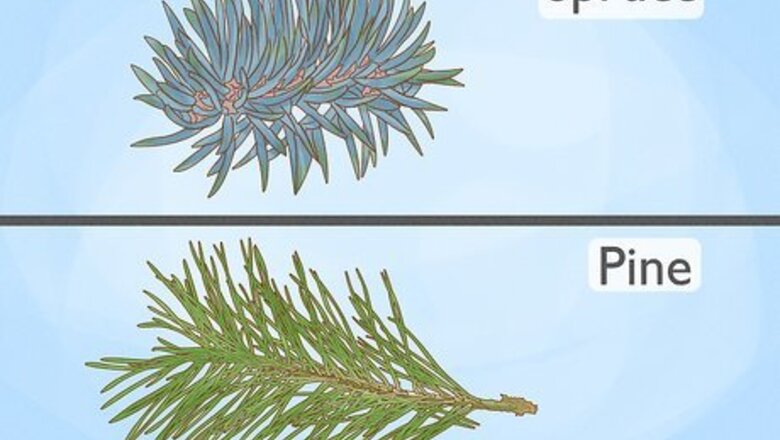
views
Examining the Tree
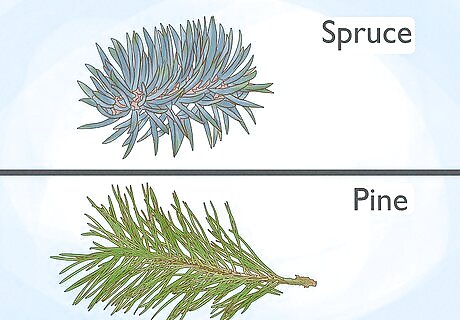
Look at the needles of the spruce. Before trying to narrow down the species of spruce tree, first make sure that you are not looking at a fir or pine. Examining the needles of the trees is the easiest way to make the distinction between them. The needles of a spruce tree are attached individually to its branches, as opposed to being in clusters. They also have four sides and roll easily between your fingers. The needles of pine trees grow in clusters, which makes them immediately distinguishable from spruce trees. Like spruce needles, the needles of fir trees also grow individually. However, while spruce tree needles are sharply pointed and easy to roll between your fingers, fir needles are flatter, less pointy, and can't be rolled between your fingers.
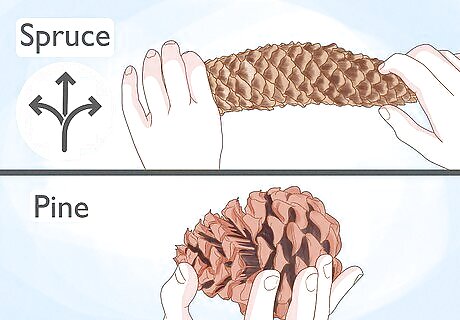
Examine the cones. The cones of a spruce tree are also a good way to identify the tree. Cones grow from tree branches and contain the seeds of a tree. Spruces, pines, and firs all contain cones, as do other conifers like cedars and hemlock trees. Spruce cones have smooth, thin scales, and are quite flexible and easy to bend. Pine cones have scales that are thick, rough and woody, which makes the cones inflexible.

Feel the branches. The needles of spruce trees grow out of small woody pegs from the branches. When the needles fall from the tree, these pegs are left behind, giving the branches a rough feel. The pegs look like little three-dimensional dots along the surface of the branch. The branches of fir and pine trees lack these stalks, and therefore feel smoother than those of spruce trees.
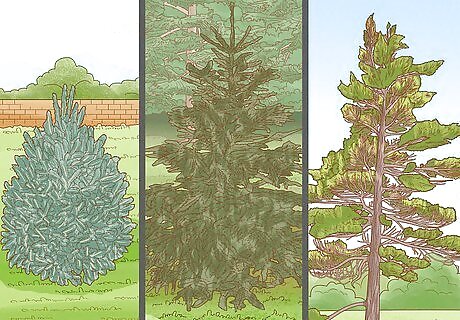
Look at the shape of the branches. Spruce trees are bushy and full, and have upturned branches. Fir trees, on the other hand, have downturned branches, making them easily distinguishable. Pine trees also have upturned branches but they have fewer branches which makes them look slightly sparser than spruce trees.
Narrowing Down the Spruce Species by Location
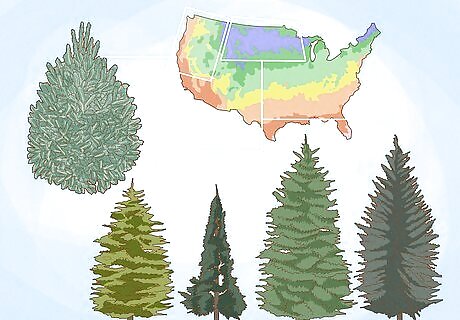
Use the region to narrow down the species. Certain kinds of spruce trees are common to certain locations. Note where the tree is located and research the kinds of spruce trees native to the area. Find an illustrated guide of trees in your region to help you identify the species of spruce. The Colorado Spruce is common throughout the Pacific Northwest and the Midwest. The Red Spruce, the Black Spruce, and the Blue Spruce are all common varieties that typically grow in the Northeast. The White Spruce and the Norway Spruce are prevalent both in the Northeast and the Northwest. There are also several varieties of spruce that are native to countries in East Asia, Turkey, and areas of Western Europe.
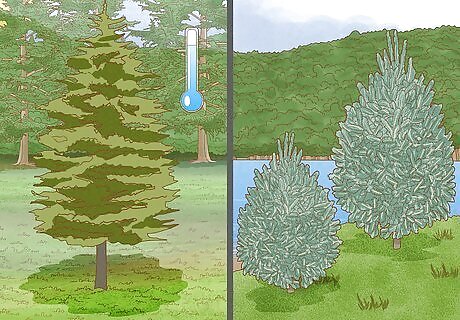
Consider the immediate area. Different spruce species flourish in different conditions. Some spruce trees tend to grow only near water sources or places with rich soil, while others do well even in harsh climates. Take into account the area in which the spruce is growing. The Colorado spruce grows best in environments that have rich, gravelly soil like the areas around rivers or streams. The Black Spruce typically grows in bogs and swamps, which is why it is also referred to as the Bog Spruce. The Red Spruce is often found in cool forests alongside other conifers. The White Spruce tends to grow in moist acidic soil around rivers or streams and often grows around other coniferous hardwood trees. The Norway Spruce can grow in a variety of cooler climates, but flourishes in moist and acidic soils.
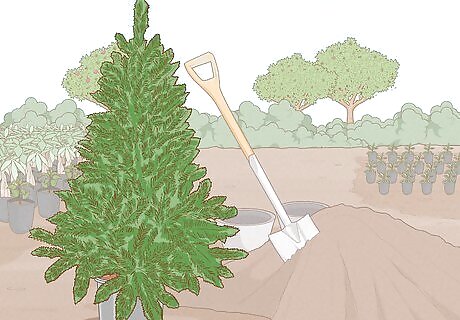
Ask the nursery to identify a Christmas spruce. If you are trying to identify a Christmas tree, you may not know where the tree came from. If you are trying to identify what kind of spruce your Christmas tree is, ask the nursery you purchased it from. If you didn't purchase it from a store or nursery, you will have to look closely at the tree to identify it. The most common spruces used as Christmas trees are the Colorado Spruce and the White Spruce.
Determining the Spruce Type
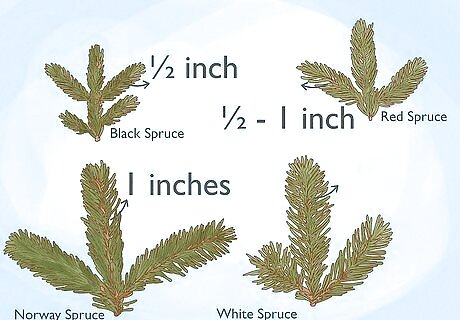
Examine the needles. The needles of the spruce differ among the various species of the tree. The color of the needles, their measurements, and even the smell when the needles are crushed can be helpful factors in identifying the tree. The Colorado Spruce has blue or blue-silver needles that are quite sharp and are ¾ to 1 ½ inches long. The Black Spruce has stubby needles that are only about ½ long. The Red Spruce has yellow-green needles around ½ - 1 inch long that give off the scent of orange rind when they are crushed. The White Spruce has bluish-green needles that give off an unpleasant scent of skunk when crushed. The Norway Spruce has dark green needles that are about 1 inch long.
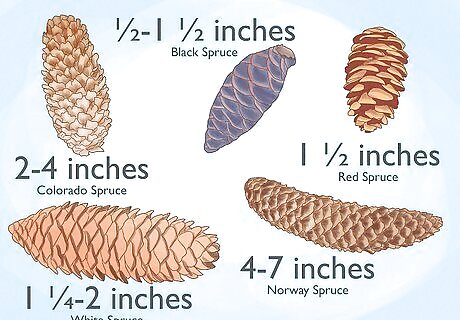
Look at the cones. The cones of spruce trees often vary between different species. Particularly pay attention to the measurements and the color of the cones. If the cones of the spruce do not match the descriptions of the most common spruces listed below, use a tree identification guide to help you narrow down the tree specie. The Colorado Spruce has dark brown cones that are around 2-4 inches long. The Black Spruce has roundish dark-purple cones that are ½ to 1 ½ inches long. The cones grow around the top of the tree. The Red Spruce has reddish-brown cones that are around 1 ½ inches long and are rough in texture. The White Spruce has thin cones that are about 1 ¼ to 2 inches in length. Its cones are light brown and very flexible. The Norway Spruce has very large distinctive cones that grow about 4-7 inches and are light brown in color.
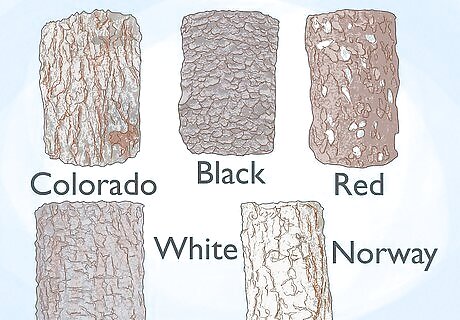
Look at the bark color. Spruce trees also have subtle variations in bark color among species. Though it may not give you an answer by itself, the bark color is also an additional factor to consider when identifying the tree. The Colorado Spruce has thin bark that forms in small scales. The bark turns from pale grey to brown as the tree ages. The Black Spruce has thin, scaly bark that is dark green-brown in color. The Red Spruce has bark with a reddish hue which is especially visible between the scales of the bark. The White Spruce has ash-brown, sometimes grayish bark. The Norway Spruce has scaly bark that is a gray-brown.
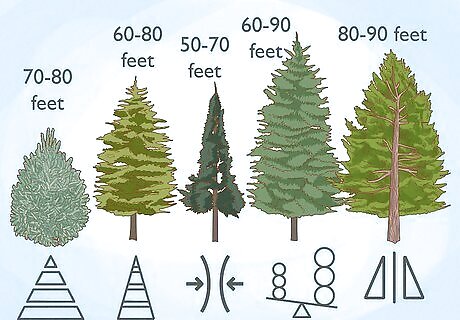
Consider the shape of the spruce. For several species of spruce, the shape of the tree is the most obvious distinguishing feature. You can also use the height of the tree to narrow down the specie, but remember that the tree may not be fully grown. In general, spruces grow about 1 ft (0.30 m) a year, so a 6–8 ft (1.8–2.4 m) tall tree is probably around 6-10 years old. The Colorado Spruce has a squat, pyramidal shape. Mature trees grow 70-80 feet tall. The Black Spruce has a narrow shape and often has a stalk-like top, since the branches at the top of the tree are quite short. It grows up to 50-70 feet tall. The Red Spruce grows straight and tall and is conical in shape/ It grows from 60-80 feet tall. The White Spruce has a broad base is often somewhat asymmetrical, especially toward the top of the tree. It grows 60-90 feet tall. The Norway Spruce grows very symmetrically, and often has branches that skim the ground, obscuring the trunk. It typically grows 80-90 feet tall.




















Comments
0 comment